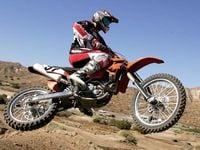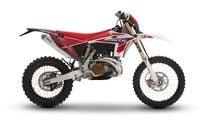KTM has had great success in recent years, due in part to its producing enough models to appeal to just about any dirt rider. The problem is a rider with a pocket full of Andrew Jacksons who is looking for a new 450cc four-stroke could walk into a well-stocked KTM dealer and (theoretically) be faced with four different models! We say theoretically because it is so rare to actually find 450 EXC models sitting on a showroom floor. At many dealers there is a waiting list for the bikes. Provided he or she found a fully stocked dealer, a savvy dirt rider would notice pretty quickly that the SMC (SuperMotard) model has slicks on it, and could dismiss that one. That still leaves the motocross-specific SX, the lights-equipped EXC and the fuel-tanker MXC. All three use the same basic frame, engine casings, suspension components, hubs and brakes, and much of the same plastic. As similar as the three are, they excel at very different aspects of the sport.However, the 450 SX and the 450 EXC tested here are aimed at the virtual opposite ends of the sport. The SX is for relatively brief blasts through the high-flying world of motocross, and the EXC is for daylong slicing through trees and trails. The MXC is located somewhere in the middle. As with the four-speed SX, it uses a close-ratio transmission, but it has two additional gears the weight-conscious SX doesn't need. The suspension is the same off-road setup the EXC uses, but the MXC has neither lights (though the ignition and wiring are capable of running lights) nor a speedo/odometer. The MXC and EXC also run an identical engine specification, electric starter, carburetor settings and spark-arrestor exhaust, which means that both are California-green-sticker-legal. The SX engine is externally identical, but it runs titanium valves (versus stainless steel), a lighter ignition, a more-radical cam, a straight-through exhaust system, a shorter stroke and larger bore and is kickstart only. Another key difference is the weight. The SX tips the scale at roughly 235 pounds, the EXC is a little more than 250 and the MXC is a couple of pounds lighter.So which bike do you need? For the purist, the answer is simple—the SX for motocross and the EXC for off-road—but how many dirt riders are truly single-faceted? Sure, KTM now has a much bigger presence in motocross, and there are many orange weapons that see only motocross use. But many KTM buyers are more well-rounded and employ their bikes for multiple uses, and thus will need a bike that will, if asked, do it all. Or at least do a couple of things well. Having the MXC in the mix of choices adds difficulty, but many dealers convert the 450 SX to a six-speed for less than $1000, and that means the choice is tougher still. So let's look at which bike does what to help make the decision easier to make.Motors
Engine performance really separates these bikes. The EXC has the smooth, tractable power that will keep the bike moving in slick, snotty conditions and while crossing wet roots and slimy rocks. It doesn't need a hit in the powerband. Flexibility is also the key word for the transmission. An enduro bike needs a low first gear for survival sections, and tightly spaced lower gears for making time in special tests; but a tall, high gear ratio helps ease the strain on the engine and the rider when there are faster transport sections between special tests. On faster dirt roads in Colorado, the EXC cruised easily at 60 to 70 mph. Some other bikes on the ride, such as the Honda CRF250X, were not at all comfortable in the fast transport sections.We used the stock California-legal lean jetting in Colorado no matter what the elevation, and the engine ran cleanly and generated more than 70 miles of mixed roads, two-track and single-track without going on reserve. The electric starting worked perfectly. For a truly nasty section and single-track, lower gearing might have been nice. We could have stayed in second gear more and shifted and used the clutch less. On a track, the EXC engine makes usable grunt and revs well but is very docile and lacks the punch for clearing some jumps easily.Conversely, the SX was a handful on the rocky, slippery trails. It squirts rocks out from under the rear tire like a fire hose if you aren't careful with the throttle. Sometimes the SX feels as if it does 35 mph in first and 45 mph in fourth. It runs out of gear very quickly, though the fifth and sixth (MXC) gears missing from the SX since '03 would make the bike a lot more friendly off-road. On the track, the gears are nearly perfect. Unlike some four-speed machines, you don't ever feel as though some of the ratios are missing. Depending on their style of riding, some testers wanted a larger rear sprocket so they could use third gear more in the turns, while others wanted a smaller rear sprocket so they could hold second gear longer. The new ignition black box is more compact for a tighter turning radius (no interference with the outer fork tubes), and it has a different curve that has livened up the power delivery. The KTM still has no real hit to the powerband compared with the Japanese 450s, so it is less intimidating for cautious riders, despite the fact that it usually has the best peak power numbers in the class. The bike is not slow!Handling and Suspension
Both models handle much the same, and there is no mistaking the ergonomics as virtually identical. Most riders jumping from one to the other notice mainly the difference in suspension setup. For '05, the KTM's WP suspension is much more intuitive to fine-tune for different riders. There is nothing tricky about setting the race sag on the linkage-free rear suspension. Actually, adjusting the shock spring is easier than on nearly any other bike. It is on the side and easy to get to. Now the sag should be set at a straight 110mm for most riders. If the spring rate is correct for you, the bike should still sag 25-35mm under its own weight without the rider aboard.These setup recommendations hold true for both bikes. We didn't feel the need for many changes. After the SX's fork broke in, the front felt a little soft, so we went in a couple of clicks on the compression. At I-5MX in Gorman, California, where we tested, some G-outs were bottoming the shock hard, so we went in one-quarter turn on the high-speed compression. You might find that you desire the same modification to the EXC, but that shock has no external high-speed adjustment. You can buy the part and install it in the EXC/MXC shocks if desired.With the adjustments, the SX was a blast on the track. It hits lines precisely, pulls out of turns strongly and vacuums up bumps easily enough. Most impressive, though, was the increased bottoming resistance. One rider forgot the finish-line jump at Los Angeles County Raceway in Palmdale, California, was not a tabletop but a double jump. The rider flattened the bike hard into the face of the second jump. On an '04 KTM, the clanking of the suspension would have stopped traffic. But he suffered no ill effects with the SX.You can stiffen the EXC/MXC enough to play on natural-terrain tracks without too many steep jump faces or flat landings. There the bike bottoms hard. However, the trail was another matter. We put nearly 300 miles on the bike traversing some challenging terrain. For Colorado's welded-to-China sharp-edged rocks, the suspension wasn't as plush as we would have liked. We had our low-mileage 2004 KTM 450 EXC along, and the seat and the suspension were a definite step back in outright plushness compared with the new model. National Enduro Champ Mike Lafferty was on the ride with a KTM 450 SX, and we swapped bikes for a short while. It was his first time on a 2005 production bike, and he was amazed at the improvement in the fork. He claimed it was the least-"sticky" WP fork he'd ridden with, though he felt it rode a little low in the stroke. You can fix that on an SX, since the bike has fork caps with externally adjustable spring preload, but not on the EXC. The EXC suspension works best at an aggressive trail pace, but on most off-road terrain it is plush and controlled enough for daylong riding.Choices
KTM has done a great job of using the same parts and basic platform to build two very different machines. Many riders will find that one or the other suits them just fine. For those who want to ride tracks and trails, there still is the MXC option, or the choice of having a dealer install fifth and sixth gears in the SX. For us, in California, the fact that the MXC is still off-road-legal would make us choose it for riding tracks, trails and GPs or hare scrambles, though it would need some suspension work if we were to get serious. But some of us prefer the EXC's thin tank and the lights for a little night action. However you make your selection, your choices are much improved for 2005, and you really can't lose. Very similar and yet totally different, these KTMs have you covered as long as you can decide which way you slide.Opinions: KTM 450 SX
When I first took out the KTM 450 SX, it felt really stiff as the track conditions were a bit rough. I simply could not get the bike to settle in the corners, and it was hard to get it to go where I needed it to go. After making a few compression adjustments to the shock and the fork, the bike felt as if it were a new machine. I went from being scared of it to having a ton of confidence in it. I was impressed with how different the bike felt with the changes we made to it. The KTM is very tunable. It just takes time to learn what to do and why to do it, but once you figure it all out, the Katoom is a real contender against any of the other bikes in its class.
Corey Neuer/5'11"/165 lb/MX IntermediateI was the only rider who spent a great deal of time on both KTM 450s. The SX is much improved. On the motocross track, it is easier to feel the added strength of the frame, but the additional suppleness and compliance of the new fork are also evident on the track with the SX and on the trail with the EXC. On the track, I love the smooth, long power of the 450 SX. It is so much easier to ride than the Japanese 450s yet still has massive boost. On the trail, the 450 EXC is amazing. The suspension is compliant; the engine is pure, tractable magic; and that awesome gearbox rules. The six-speed has a get-you-out-of-trouble first gear, and the digital speedo will still read 90 mph in fifth and sixth gear! Really, this is a magic bike. For my style of riding—some track and a lot of trail with a few GPs and hare scrambles thrown in—the MXC will probably be the one that ends up in my garage.
Karel Kramer/6'1"/200 lb/B riderMore 450 motocross bike tests:


/cloudfront-us-east-1.images.arcpublishing.com/octane/SQ3CEIVCOJF7FDERDVDKKPIC7A.jpg)
/cloudfront-us-east-1.images.arcpublishing.com/octane/LLLQLRK2DBH4PN66MDNA3AFJNY.jpg)
/cloudfront-us-east-1.images.arcpublishing.com/octane/5DMU4K752FBWLLJD432GRAAH2A.jpg)
/cloudfront-us-east-1.images.arcpublishing.com/octane/TGHDVMIODJC4BNKJDZKKTSWXWI.jpg)
/cloudfront-us-east-1.images.arcpublishing.com/octane/5KYMT24REJEFPNO2J2M76MXERM.jpg)

/cloudfront-us-east-1.images.arcpublishing.com/octane/3GXGR3EKSNH5NI3CWHV5SJ7TXE.jpg)
/cloudfront-us-east-1.images.arcpublishing.com/octane/JEU3ONDWEFCAZNAZJOU24OJ2PM.jpg)
/cloudfront-us-east-1.images.arcpublishing.com/octane/JQ6LMK6LLBAQJIL2AH56UIUKWU.jpg)
/cloudfront-us-east-1.images.arcpublishing.com/octane/QUSF4LLRM5DDPCJW25RINQRJPE.jpg)
/cloudfront-us-east-1.images.arcpublishing.com/octane/FYDGK7GF4JBPXERA5RAZPY3YJI.jpg)
/cloudfront-us-east-1.images.arcpublishing.com/octane/JE7KMNASNRGR7FLYAFRZAR7T7E.jpg)
/cloudfront-us-east-1.images.arcpublishing.com/octane/7RCNKJJNXBF4LBKZXE2INNWZUY.jpg)
/cloudfront-us-east-1.images.arcpublishing.com/octane/BAGM5E4EWBHFNLZOXMSLOLKQGU.jpg)
/cloudfront-us-east-1.images.arcpublishing.com/octane/RSX65VBXY5FRLIY4LN6WLOKAFM.jpg)
/cloudfront-us-east-1.images.arcpublishing.com/octane/3EO2CNKWUFBGNMGNJPETW5HCNY.jpg)
/cloudfront-us-east-1.images.arcpublishing.com/octane/IYHM55XRNVHF3DSS3467PZ7ONQ.jpg)
/cloudfront-us-east-1.images.arcpublishing.com/octane/L7K3FIINEBHMZI2TXTUE4FXH7I.jpg)
/cloudfront-us-east-1.images.arcpublishing.com/octane/XE7P5YXNZZDUTIGW4YNWQRDVY4.jpg)
/cloudfront-us-east-1.images.arcpublishing.com/octane/AV55DOHQ3BEXJLPWR6UWLYUSAQ.jpg)
/cloudfront-us-east-1.images.arcpublishing.com/octane/MMROGOYHXZAYDC4RKIDJ4VRSGA.jpg)
/cloudfront-us-east-1.images.arcpublishing.com/octane/FHRWLPEOTBFOHFTQLIHJNIXCFQ.jpg)
/cloudfront-us-east-1.images.arcpublishing.com/octane/J2RUDOXTOZHBXOFCUQKBAGBMAQ.jpg)
/cloudfront-us-east-1.images.arcpublishing.com/octane/UDQASRGJ3ZDG3BANXWU6P5NIQY.jpg)